- Главная
- Без категории
- New Microsoft PowerPoint Presentation-1

Содержание
- 2. The World Health Organization (WHO) is a specialized agency of the United Nations responsible for international
- 3. ESTABLISHMENT The World Health Organization (WHO) is a specialized agency of the United Nations responsible for
- 4. STRUCTURE WHO, like many other international organizations, has a somewhat complex organizational structure. The headquarters is
- 5. HEAD QUARTER OF GINIVA
- 6. ROLE Providing leadership on matters critical to health and engaging in partnerships where joint action is
- 7. ACHIEVEMENTS 1947: The WHO established an epidemiological information service via telex, and by 1950 a mass
- 8. GOALS Providing leadership on matters critical to health and engaging in partnerships where joint action is
- 9. CONTROVERSIES It has been alleged that the WHO was aware of a Dr. Hilary Koprowski, a
- 10. PARTNERSHIP The WHO is financed by contributions from member states and outside donors. As of 2012,
- 11. RELATIONS WITH OTHER ORGANIZATION
- 13. Скачать презентацию
The World Health Organization (WHO) is a specialized agency of the United Nations responsible for
The World Health Organization (WHO) is a specialized agency of the United Nations responsible for
The WHO Constitution, which establishes the agency's governing structure and principles, states its main objective as ensuring "the attainment by all peoples of the highest possible level of health."
ESTABLISHMENT
The World Health Organization (WHO) is a specialized agency of the United Nations responsible for
ESTABLISHMENT
The World Health Organization (WHO) is a specialized agency of the United Nations responsible for
The WHO Constitution, which establishes the agency's governing structure and principles, states its main objective as ensuring "the attainment by all peoples of the highest possible level of health.“
It is established at 7 April 1948 . Headquarters are in Switzerland and Geneva.
STRUCTURE
WHO, like many other international organizations, has a somewhat complex organizational
STRUCTURE
WHO, like many other international organizations, has a somewhat complex organizational
The World Health Assembly (WHA) is the legislative and supreme body of WHO. Based in Geneva, it typically meets yearly in May. It appoints the Director-General every five years and votes on matters of policy and finance of WHO, including the proposed budget. It also reviews reports of the Executive Board and decides whether there are areas of work requiring further examination. The Assembly elects 34 members, technically qualified in the field of health, to the Executive Board for three-year terms.
HEAD QUARTER OF GINIVA
HEAD QUARTER OF GINIVA
ROLE
Providing leadership on matters critical to health and engaging in partnerships
ROLE
Providing leadership on matters critical to health and engaging in partnerships
Shaping the research agenda and stimulating the generation, translation and dissemination of valuable knowledge;
Setting norms and standards and promoting and monitoring their implementation;
Articulating ethical and evidence-based policy options;
Providing technical support, catalysing change, and building sustainable institutional capacity; and
Monitoring the health situation and assessing health trends
ACHIEVEMENTS
1947: The WHO established an epidemiological information service via telex, and by 1950 a mass tuberculosis
ACHIEVEMENTS
1947: The WHO established an epidemiological information service via telex, and by 1950 a mass tuberculosis
1955: The malaria eradication programme was launched, although it was later altered in objective. 1955 saw the first report on Diabetesmellitus and the creation of the International Agencyfor Research on Cancer.
1966: The WHO moved its headquarters from the Ariana wing at the Palace of Nations to a newly constructed HQ elsewhere in Geneva.
2000: The Stop TB Partnership was created along with the UN's formulation of the Millennium Development Goals.
GOALS
Providing leadership on matters critical to health and engaging in partnerships
GOALS
Providing leadership on matters critical to health and engaging in partnerships
Shaping the research agenda and stimulating the generation, translation, and dissemination of valuable knowledge.
setting norms and standards and promoting and monitoring their implementation;
articulating ethical and evidence-based policy options;
providing technical support, catalysing change, and building sustainable institutional capacity; and
monitoring the health situation and assessing health trends.
CONTROVERSIES
It has been alleged that the WHO was aware of a Dr. Hilary Koprowski,
CONTROVERSIES
It has been alleged that the WHO was aware of a Dr. Hilary Koprowski,
The aggressive support of the Bill & Melinda Gates Foundation for intermittent preventive therapy of malaria triggered a memo from the former WHO malaria chief Akira Kochi.
PARTNERSHIP
The WHO is financed by contributions from member states and outside
PARTNERSHIP
The WHO is financed by contributions from member states and outside
There were 189 partnerships with international NGOs in formal "official relations" – the rest being considered informal in character. Partners include the Bill and Melinda Gates Foundation and the Rockefeller Foundation.
RELATIONS WITH OTHER ORGANIZATION
RELATIONS WITH OTHER ORGANIZATION



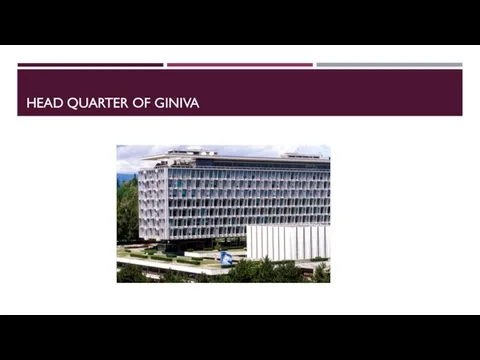
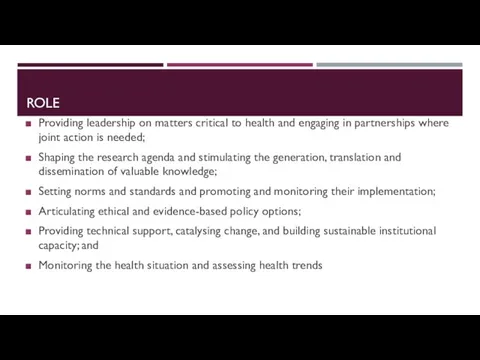
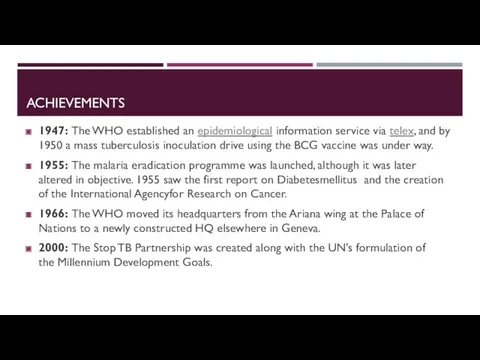
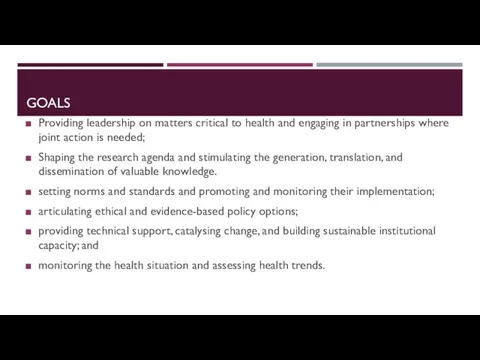
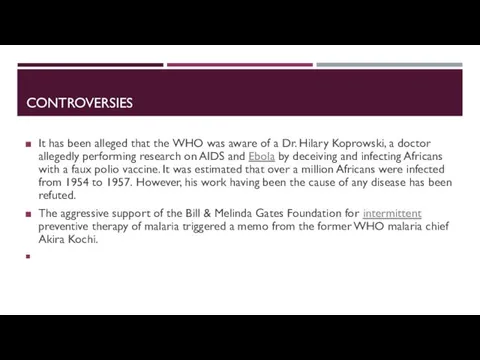
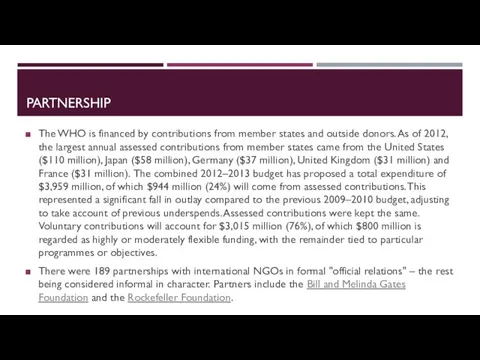
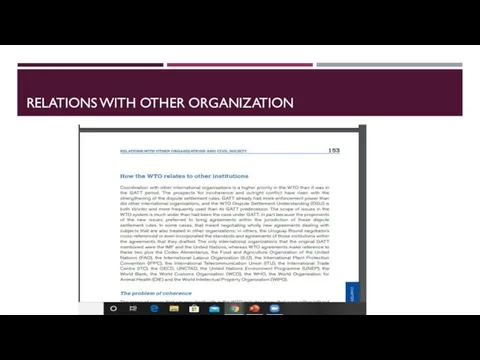
 Машинные стежки и строчки
Машинные стежки и строчки Образовательная и просветительская деятельность Русской Православной Церкви
Образовательная и просветительская деятельность Русской Православной Церкви Шаблоны Templatemonster. Сайт. Основы локальных сетей. (Занятие 4.1)
Шаблоны Templatemonster. Сайт. Основы локальных сетей. (Занятие 4.1) Этапы освещения темы Великой Отечественной войны в произведениях советских писателей
Этапы освещения темы Великой Отечественной войны в произведениях советских писателей Понятие функции. Свойства функций. Линейная и квадратичная функции. Лекция 1-1
Понятие функции. Свойства функций. Линейная и квадратичная функции. Лекция 1-1 Набережные Челны
Набережные Челны Классические этапы разработки стратегии. Внешний анализ
Классические этапы разработки стратегии. Внешний анализ Общественная работа учителя. Создание ТОСа Память
Общественная работа учителя. Создание ТОСа Память Презентация. Великая Отечественная война.
Презентация. Великая Отечественная война. В.П. Астафьев Рождённый Сибирью
В.П. Астафьев Рождённый Сибирью Общешкольное родительское собрание
Общешкольное родительское собрание Презентация к родительскому собранию Влияние родителей на успеваемость ребенка
Презентация к родительскому собранию Влияние родителей на успеваемость ребенка Сопоставление художнического видения природы Алтая Н. Рубцова и Г. Гуркина
Сопоставление художнического видения природы Алтая Н. Рубцова и Г. Гуркина Ырғақ бұзылыстары
Ырғақ бұзылыстары Как вести себя в школе.
Как вести себя в школе. Шаблоны презентаций Ромашки 2
Шаблоны презентаций Ромашки 2 : Вежливость.
: Вежливость. Профилактика, диагностика и лечение туберкулеза
Профилактика, диагностика и лечение туберкулеза Сочетание речевых средств и невербальных действий
Сочетание речевых средств и невербальных действий Мешочек для новогоднего подарка
Мешочек для новогоднего подарка Программно-нормативные основы физического воспитания школьников
Программно-нормативные основы физического воспитания школьников Доклад + презентация к родительскому собранию
Доклад + презентация к родительскому собранию Теория литературы в школьном изучении
Теория литературы в школьном изучении Православные праздники
Православные праздники Славутыя дзеячы навукі і культуры
Славутыя дзеячы навукі і культуры Окислительно - восстановительные реакции
Окислительно - восстановительные реакции Web-дизайн. Введение в цветоведение
Web-дизайн. Введение в цветоведение Обществознание: право и жизнь человека, общества и государства (8 класс)
Обществознание: право и жизнь человека, общества и государства (8 класс)